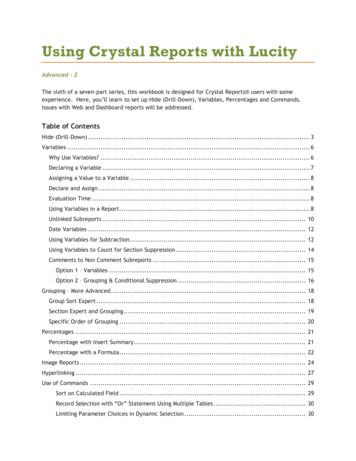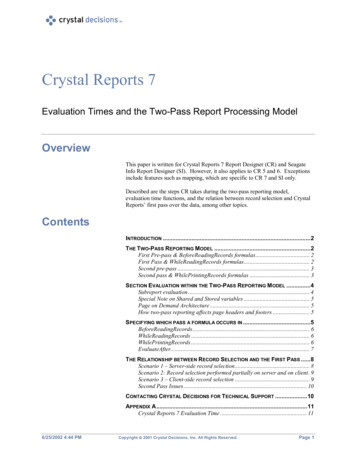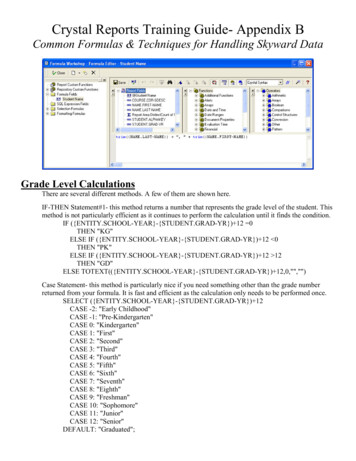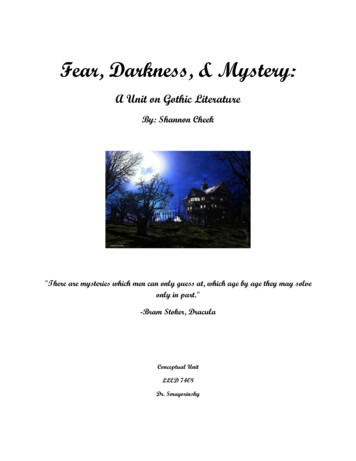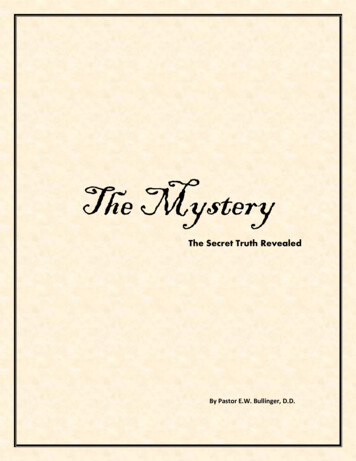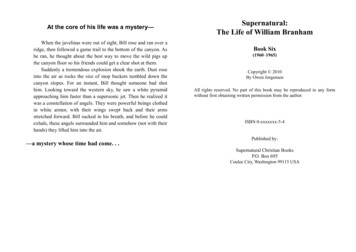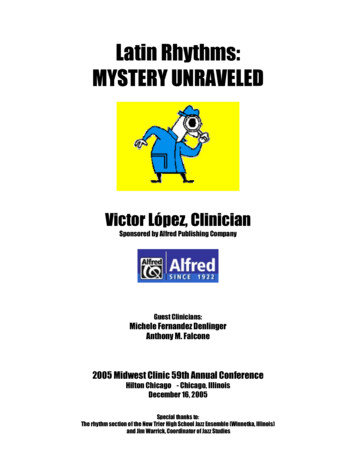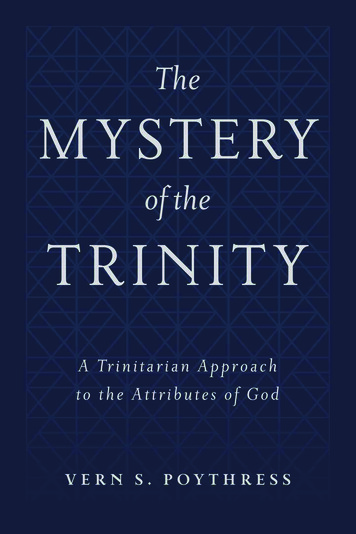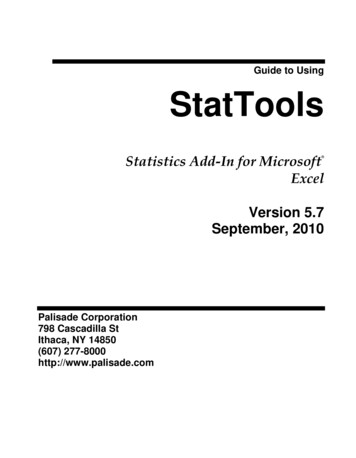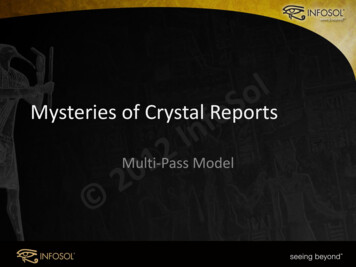
Transcription
Mysteries of Crystal ReportsMulti-Pass Model
Agenda PurposeDefining the Multi-PassStepping in itLassoing the DragonExamplesBest PracticesConclusionQuestions
Purpose Intended for anyone who uses or hasconsidered using Crystal reports for anyversion including the new one(s). Why do I care again how Crystal does things?– Helps us understand why the tool behaves theway it does and what we can do to takeadvantage/avoid issues with it. Why did they make the tool so complex? But I don’t use Crystal
Defining the Multi-Pass The Multi-Pass model is how Crystal reports calculatesall variables, formulas and displays information on yourreport. Has a considerable impact on performance. Can influence results. Sub-Reports, running totals, shared/global variablesare all impacted sometimes in unexpected ways! Basically it is the path and methodology that the tooluses to create reports. Best diagram is a flow chart but this can be confusingas there is a path on the document as well, top tobottom, one section at a time, left to right!
Defining the Multi-Pass
Defining the Multi-Pass
Stepping In It Summary Running total problem– Typically caused by top n sort or group sort. Manual running totals.Sub-reports not totaling correctly.Formulas with variables not working correctly.Array loading issues.Page N/M slows down my report by howmuch?!?!?
Lassoing the Dragon Special Functions– WhilePrintingRecords Often used as a panacea for all formulas– WhileReadingRecords Not used often– BeforeReadingRecords Not used often– EvaluateAfter(x) Decide what functions/summaries you will use based onyour final report usage– Avoid summary functions if there is any doubt!– Watch out for surprises with sub-report pass through values Know your enemy!
Examples Sum / Running Total Differences– Caused by Top N (Group Sort) Loading Arrays– Declarations and redims must be doneWhilePrintingRecords– Note that we can load arrays dynamically due to thismodel! So it’s not all that bad. Subreport Processing– Subreports are always evaluated in pass 2, ensure all otherformulas using them do too! Manual Running Totals– Oops, when do they reset again?
Best Practices Avoid the Page N/M (unless you are usingCrystal for Enterprise and maybe everyoneelse in the next version?) Add WhilePrintingRecords to all formulas withvariables? Avoid using summary functions if you havesubreports, variables or anything that mighthave pass issues To be forewarned is to be forearmed!
Conclusion Each report should be reviewed for overallpass logic issues. All formulas with variables should be reviewedconsidering pass location. Beyond the actual pass process, the locationin sections also affects report behavior. Don’t overthink the pass model, just don’tforget about it either!
Questions12
Defining the Multi-Pass (Help File)Pre-Pass #1 When previewing a report, the first elements to be evaluated are "constant" formulas. Constant formulas arethose that have a constant value for the entire report. They do not change from record to record. For example,100* 30 would be a constant formula. Constant formulas are evaluated at the beginning of the print generationprocess and are never evaluated again. This process is known as "BeforeReadingRecords." If you were to place aconstant formula field (i.e., 100*30) in the Details section, the result would be 3000 for each record displayed.Pass #1 After the "BeforeReadingRecords" process has taken place, Crystal Reports begins reading the database records.During the record reading process, the following will occur: Record retrieval. Where possible record selection and sorting are pushed down to the database in this step. Evaluation of recurring formulas. These formulas are those that contain database fields but do not containreferences to subtotals or summary information. This evaluation time is known as "WhileReadingRecords."Formulas that contain references to subtotals or summary information are processed in the second pass. Application of the record selection locally. If the record selection is too complex to be pushed down to thedatabase, it is applied by Crystal Reports in this step. Application of the saved data record selection formulas. When records return to the report, they are furtherfiltered through any existing saved data formulas. Sorting, grouping, and totaling. In this step, Crystal Reports sorts the records, separates them into groups, andthen calculates the subtotals and summaries needed for each group. Cross-Tab, chart, and map generation. Only Cross-Tabs, charts, and maps that are based entirely on database fieldsand recurring formulas are generated in Pass 1. If these objects include running totals and/or PrintTime formulas,they are generated in Pass 2. Storage of saved data. After the totaling process is complete, all of the records and totals are stored in memoryand to temporary files. Crystal Reports does not read the database again, but instead uses this saved data duringall subsequent processing.
Defining the Multi-Pass (Help File)Pre-Pass #2 During Pre-Pass 2, Crystal Reports orders the groups in the report for Top/Bottom N or Hierarchical Grouping. The records are not read in thisprocess, instead Crystal Reports only looks at group instances from Pass 1, and takes the Top N as appropriate, or orders the groups based on theHierarchical Grouping settings specified.Pass #2 Crystal Reports enters the second pass through the data to format pages. The pages are formatted on demand. This means that Crystal Reports willnot format a page until it is requested by the user, or until it is required for the total page count in Pass 3. During page formatting, Crystal Reports does the following: Group selection formulas. Running totals. Calculation of formulas marked "WhilePrinting Records." These are formulas that contain references to subtotals or summary information, also known as "PrintTime" formulas. This evaluation time is knownas "WhilePrinting Records." Cross-Tabs, charts, and maps. Cross-Tabs, charts, and maps that include running totals and/or PrintTime formulas, and charts that are based on Cross-Tabs are generated in Pass 2. OLAP grids. Subreports. Generation of Pages on Demand. Note: Subtotals, grand totals, and summaries may appear to be incorrect if the report has a group selection formula. This occurs because the grand totalsand summaries are calculated during Pass 1, but the group selection formula filters the data again in Pass 2. Running total fields can be used insteadof summaries to total data in reports with a group selection formula. You can use on-demand subreports to ensure that your main report remains a single-pass report. With on-demand subreports, Crystal Reports muststill make a second pass through the data; however, this second pass does not begin until you drill down on the subreport. Consequently, you canincrease the performance of reports that contain subreports by using on-demand subreports.Pass #3 In the third, and final pass, the total page count is determined. This applies to reports that use the total page count, or Page N of M special fields.
Crystal Reports enters the second pass through the data to format pages. The pages are formatted on demand. This means that Crystal Reports will not format a page until it is requested by the user, or until it is required for the total page count in Pas
